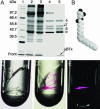Electron microscopic evidence for nucleation and growth of 3D acetylcholine receptor microcrystals in structured lipid-detergent matrices
- PMID: 13679581
- PMCID: PMC208753
- DOI: 10.1073/pnas.1834451100
Electron microscopic evidence for nucleation and growth of 3D acetylcholine receptor microcrystals in structured lipid-detergent matrices
Abstract
Nicotinic acetylcholine receptors (AChRs) belong to a superfamily of oligomeric proteins that transduce electric signals across the cell membrane on binding of neurotransmitters. These receptors harbor a large extracellular ligand-binding domain directly linked to an ion-conducting channel-forming domain that spans the cell membrane 20 times and considerably extends into the cytoplasm. Thus far, none of these receptor channels has been crystallized in three dimensions. The crystallization of the AChR from Torpedo marmorata electric organs is challenged here in lipidic-detergent matrices. Detergent-soluble AChR complexed with alpha-bungarotoxin (alphaBTx), a polypeptidic competitive antagonist, was purified. The AChR-alphaBTx complex was reconstituted in a lipidic matrix composed of monoolein bilayers that are structured in three dimensions. The alphaBTx was conjugated to a photo-stable fluorophore, enabling us to monitor the physical behavior of the receptor-toxin complex in the lipidic matrix under light stereomicroscope, and to freeze fracture regions containing the receptor-toxin complex for visualization under a transmission electron microscope. Conditions were established for forming 2D receptor-toxin lattices that are stacked in the third dimension. 3D AChR nanocrystals were thereby grown inside the highly viscous lipidic 3D matrix. Slow emulsification of the lipidic matrix converted these nanocrystals into 3D elongated thin crystal plates of micrometer size. The latter are stable in detergent-containing aqueous solutions and can currently be used for seeding and epitaxial growth, en route to crystals of appropriate dimensions for x-ray diffraction studies.
Figures





Similar articles
-
Three-dimensional structure of the nicotinic acetylcholine receptor and location of the major associated 43-kD cytoskeletal protein, determined at 22 A by low dose electron microscopy and x-ray diffraction to 12.5 A.J Cell Biol. 1989 Aug;109(2):755-74. doi: 10.1083/jcb.109.2.755. J Cell Biol. 1989. PMID: 2760111 Free PMC article.
-
The intactness and orientation of acetylcholine receptor-rich membrane from Torpedo californica electric tissue.Arch Biochem Biophys. 1989 Aug 1;272(2):412-20. doi: 10.1016/0003-9861(89)90235-x. Arch Biochem Biophys. 1989. PMID: 2751309
-
Assessment of the functionality and stability of detergent purified nAChR from Torpedo using lipidic matrixes and macroscopic electrophysiology.Biochim Biophys Acta. 2016 Jan;1858(1):47-56. doi: 10.1016/j.bbamem.2015.10.002. Epub 2015 Oct 8. Biochim Biophys Acta. 2016. PMID: 26454038 Free PMC article.
-
The nicotinic acetylcholine receptor of the Torpedo electric ray.J Struct Biol. 1998;121(2):181-90. doi: 10.1006/jsbi.1997.3949. J Struct Biol. 1998. PMID: 9615437 Review.
-
Lipid matters: nicotinic acetylcholine receptor-lipid interactions (Review).Mol Membr Biol. 2002 Oct-Dec;19(4):277-84. doi: 10.1080/09687680210166226. Mol Membr Biol. 2002. PMID: 12512774 Review.
Cited by
-
Crystal structure of a Cbtx-AChBP complex reveals essential interactions between snake alpha-neurotoxins and nicotinic receptors.EMBO J. 2005 Apr 20;24(8):1512-22. doi: 10.1038/sj.emboj.7600620. Epub 2005 Mar 24. EMBO J. 2005. PMID: 15791209 Free PMC article.
-
Effects of lipid-analog detergent solubilization on the functionality and lipidic cubic phase mobility of the Torpedo californica nicotinic acetylcholine receptor.J Membr Biol. 2011 Oct;243(1-3):47-58. doi: 10.1007/s00232-011-9392-4. Epub 2011 Sep 16. J Membr Biol. 2011. PMID: 21922299 Free PMC article.
-
Exploring the in meso crystallization mechanism by characterizing the lipid mesophase microenvironment during the growth of single transmembrane α-helical peptide crystals.Philos Trans A Math Phys Eng Sci. 2016 Jul 28;374(2072):20150125. doi: 10.1098/rsta.2015.0125. Philos Trans A Math Phys Eng Sci. 2016. PMID: 27298442 Free PMC article.
-
Role of glycosylation and membrane environment in nicotinic acetylcholine receptor stability.Biophys J. 2005 Mar;88(3):1755-64. doi: 10.1529/biophysj.104.052944. Epub 2004 Dec 30. Biophys J. 2005. PMID: 15626708 Free PMC article.
-
Normal mode analysis suggests a quaternary twist model for the nicotinic receptor gating mechanism.Biophys J. 2005 Jun;88(6):3954-65. doi: 10.1529/biophysj.104.050229. Epub 2005 Apr 1. Biophys J. 2005. PMID: 15805177 Free PMC article.
References
-
- Rosenbusch, J. P. (2001) J. Struct. Biol. 136, 144–157. - PubMed
-
- Corringer, P. J., Le Novere, N. & Changeux, J. P. (2000) Annu. Rev. Pharmacol. Toxicol. 40, 431–458. - PubMed
-
- Karlin, A. (2002) Nat. Rev. Neurosci. 3, 102–114. - PubMed
-
- Engel, A. G., Ohno, K. & Sine, S. M. (2003) Nat. Rev. Neurosci. 4, 339–352. - PubMed
Publication types
MeSH terms
Substances
LinkOut - more resources
Full Text Sources
Other Literature Sources
Research Materials

